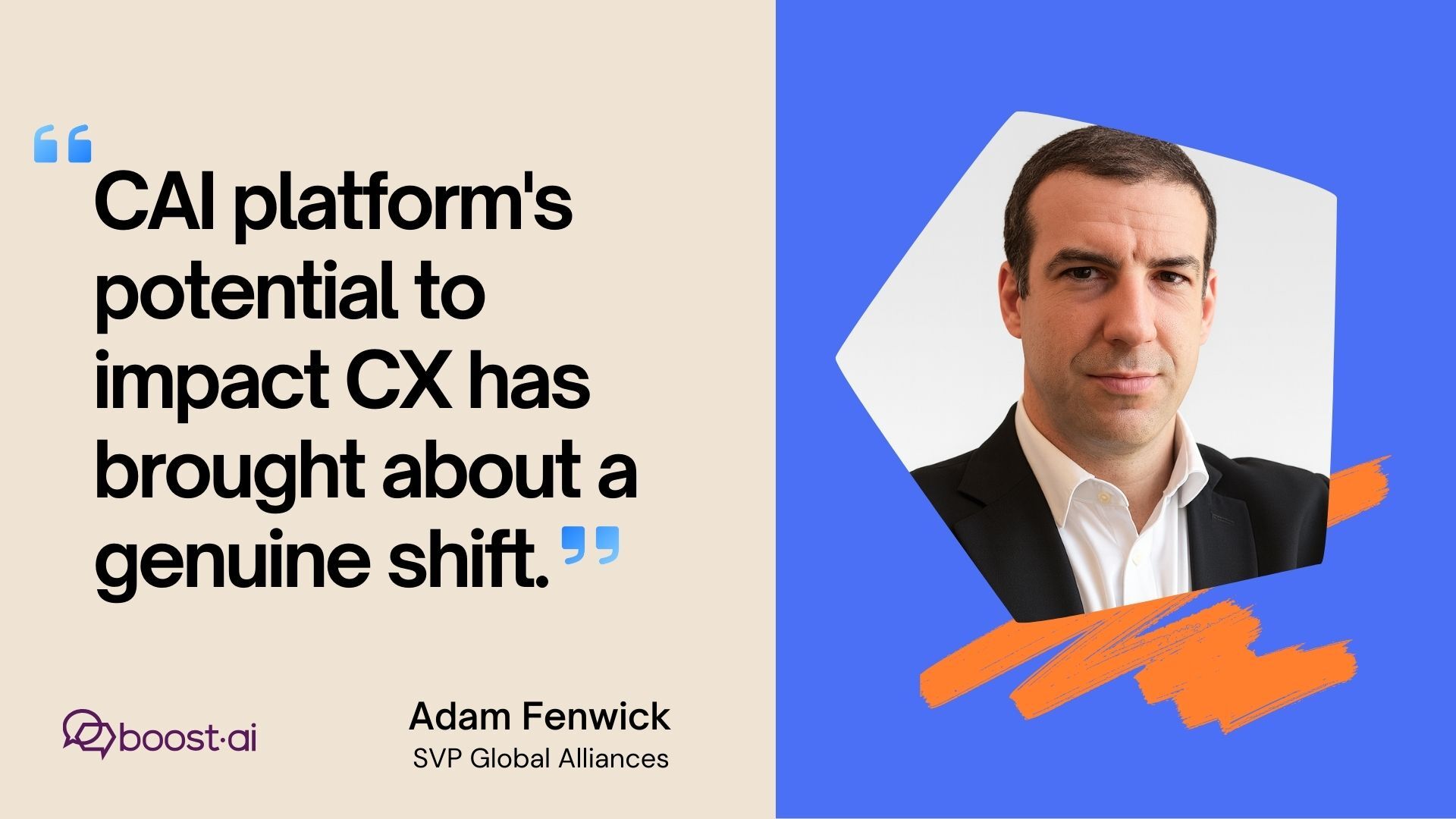Against a frenzy of AI jargon and noise rippling through the market, one concept is increasingly emerging as most potent when it comes to generating actual results - Customer Experience (hereafter CX). This marks maturing thinking around what AI can deliver. Conversational AI (hereafter CAI) platforms can now act as the primary interface for brands, meeting both customers and employees where they are in any channel, at any time, and in any language. This conversational layer offers brands the ability to re-examine their customer journeys end-to-end, creating improvements that deliver a real competitive edge. For vendors, controlling the customer conversation offers unprecedented stickiness and ROI against a backdrop where, according to MIT, 95% of GenAI projects in the market haven’t delivered a return.1 This has resulted in a dramatic shift in the competitive landscape with software companies scrambling to position themselves as being able to help transform CX, from CRM and CCaaS giants to dedicated CAI providers and GenAI start-ups.
The ‘Why’
Why is CX so critical when thinking about where to focus with AI? CAI offers a future where a single channel seamlessly interacts with customers, transitioning between modes like video and chat.2 Gartner® predicted that by 2028, 30% of Fortune 500 companies will offer service only through a single, AI-enabled channel.3 This marks an irreversible change in customer behaviour that brands must cater to now. For vendors, being able to control every customer interaction brings many possibilities; a detailed understanding of a customer’s intent and how best to prioritise and personalise a journey for them, commanding immense value. This extends to customising what customers see, filtering out non-useful material to deliver a journey and experience that makes someone feel important and tailored to them. Financially, the data is already compelling; spending on CAI will rise from $14.6Bn this year to north of $32Bn by 2027.4
Who Leads?
Who is winning this race to dominate customer service interactions? NiCE’s recent acquisition of Cognigy raised eyebrows for its size/valuation, but proves global established players recognise the need to act now.5 C.$1Bn bought NiCE a platform to leverage this opportunity to control the top of the stack whilst mitigating the risk of another AI vendor coming above them and thus control when/where customers are passed to the NiCE platform. Salesforce’s huge bet on Agentforce and rival ServiceNow acquiring Moveworks for another big multiple are other examples.6 Everyone from Microsoft to Workday is pushing agentic features into their platforms and trying to argue they can orchestrate customer journeys via their platforms.7 Those that will endure are those able to evidence this capability at scale. Dedicated CAI vendors are in a unique position here; the latest Magic Quadrant™ evidenced that few such platforms meet Enterprise regulatory standards and have reached escape velocity size to be able to support customers consistently.8 Whilst a fraction of the size of SaaS giants, CAI companies create an outsized impact due to their feature-rich offerings and increasingly rare talent that enables and supports customers, generating continuous value.
Buyer Strategy
What does focusing investment on CX mean for brands then? Control might be the biggest factor. If the majority of customers are engaging via AI first, being able to control and design what happens next to deliver the best possible experience is vital. Customers/Employees don’t care about underlying systems or integrations; their experience is everything. Making money from AI, not just saving costs, is also growing hugely in decisioning. AI-powered conversation design opens up opportunities for cross-selling that were simply not available to human agents. Driving real value, therefore, requires careful vendor selection; looking beyond marketing ‘dash’ for a partner who can really deliver end-to-end outcomes and meet Enterprise security/risk standards, not just pilots with non-scalable business cases. Ease of integration is certainly key; CAI is gated by the knowledge it can access in the back end. Open architecture and flexible modularity are also important.
Customers ‘bringing their own’ components to bear (e.g., tuned LLMs) often produce the best results. What to measure also needs to take centre stage. Companies seek to measure vast numbers of metrics; relevant classics like FTE equivalents and AHT through to NPS and retention.
Risks
Single vendor lock-in in as with the big hyperscalers, is a familiar risk here. The reverse is true; hedging bets, federating different AI tools in different functions can seem prudent early on, but beware the department-specific pitches that purport to offer something special that needs to be isolated from a programme driving CX across an entire organisation. The scale of the investments being made by the largest companies presents a real threat to the existence of smaller firms. Acquisitions and failures will continue apace. Trust is a defining aspect of AI being allowed anywhere near end customers. Standards are rightly increasing all the time, fuelled by an evolving regulatory picture, such as the EU AI Act being rolled out.9 AI committees within Enterprises combine with the first principle that governance, control, and supervision must increase as AI carries more of the workload. High-profile consumer-facing errors retain notoriety long after events take place, serving as cautionary reminders.10
Conclusion
CAI platform's potential to impact CX has brought about a genuine shift. Today’s battleground revolves around who controls the customer journey from the outset, superseding all other technologies. For vendors, this offers a path to long-term market dominance. For buyers increasingly in need of an elegant omnichannel solution, choosing the right partner is a critical business decision. Trust, flexibility, and outcomes-driven platforms with a deployment track record in Enterprise are absolutely essential if a brand is to succeed in delighting its customers, and what could be more important than that in today’s AI-powered environment?
1 MIT, Jul 2025 <https://mlq.ai/media/quarterly_decks/v0.1_State...>.
2 Gartner, Predicts 2025: Voice-Based Customer Service Isn’t Going Anywhere, 06 Dec 2024 <https://www.gartner.com/en/documents/5991771>.
3 Ibid
4 Juniper Research, 'Conversational AI to Generate $57 Billion of Revenue Globally Over Next Three Years', 18 Feb 2025 <https://www.juniperresearch.com/research/teleco...>.
5 Forbes, NiCE’s $955M Cognigy Deal Targets $30B AI Customer Experience Opportunity, 29 Jul 2025 <https://www.forbes.com/sites/maribellopez/2025/...>.
6 Reuters, ServiceNow adds AI muscle with record $2.9 billion Moveworks deal, 10 Mar 2025 <https://www.reuters.com/technology/servicenow-b...>; ITPro, Salesforce wants to show what “AI was always meant to be” – Dreamforce 2024 is its chance to do it, 15 Sep 2024 <https://www.itpro.com/technology/artificial-int...>.
7 Microsoft <https://copilot.microsoft.com/>; Workday <https://www.workday.com/en-us/artificial-intell...>.
8 Gartner, Gartner Magic Quadrant for Conversational AI Platforms, 13 Aug 2025 <https://www.gartner.com/en/documents/6835734>; boost.ai, boost.ai named a Leader in 2025 Gartner® Magic Quadrant™ for Conversational AI Platforms, Jul 2025 <https://boost.ai/guides/gartner-magic-quadrant-...>.
9 European Parliament, EU AI Act: first regulation on artificial intelligence, 08 Jun 2023 <https://www.europarl.europa.eu/topics/en/articl...>.
10 CIO, 11 famous AI disasters, 07 Aug 2025 <https://www.cio.com/article/190888/5-famous-ana...>.



